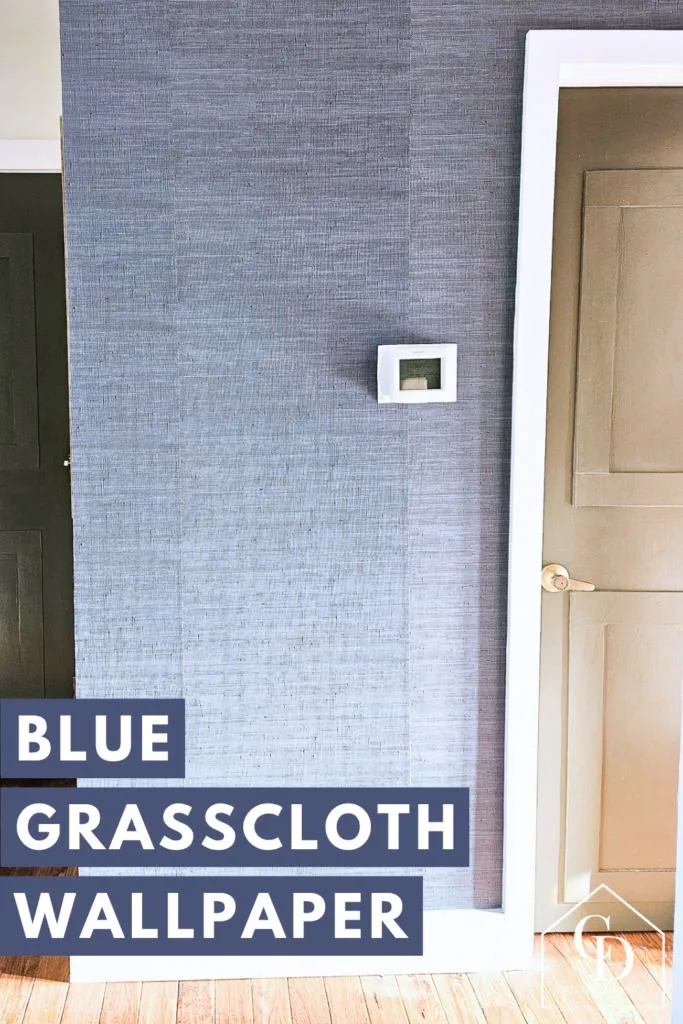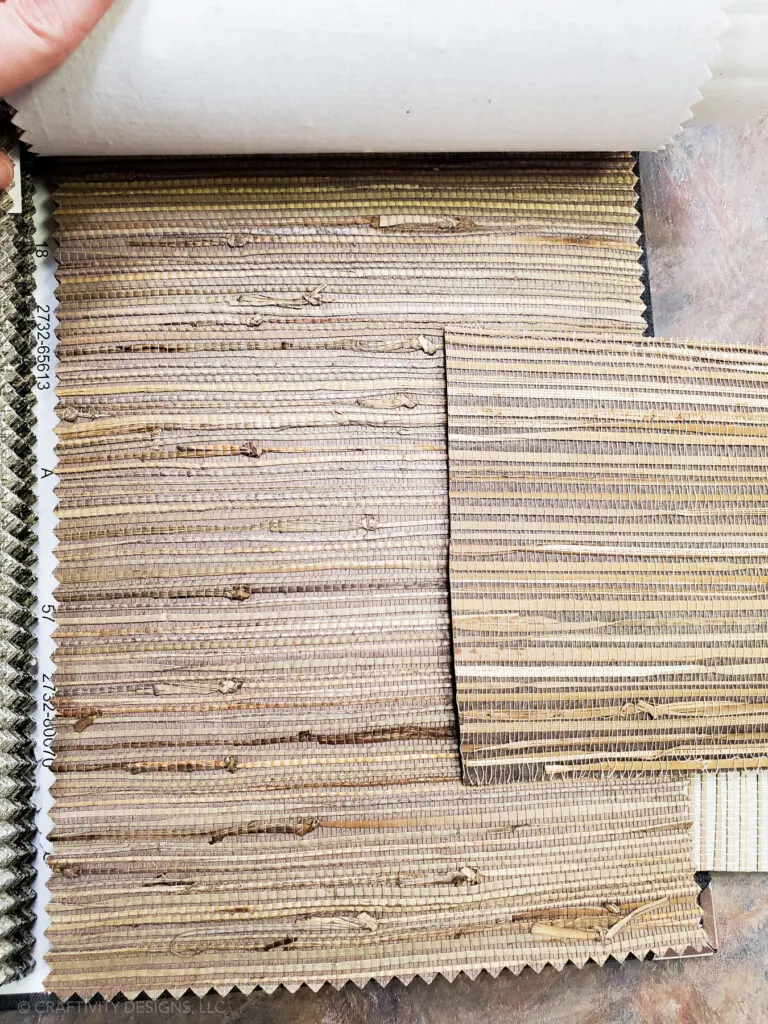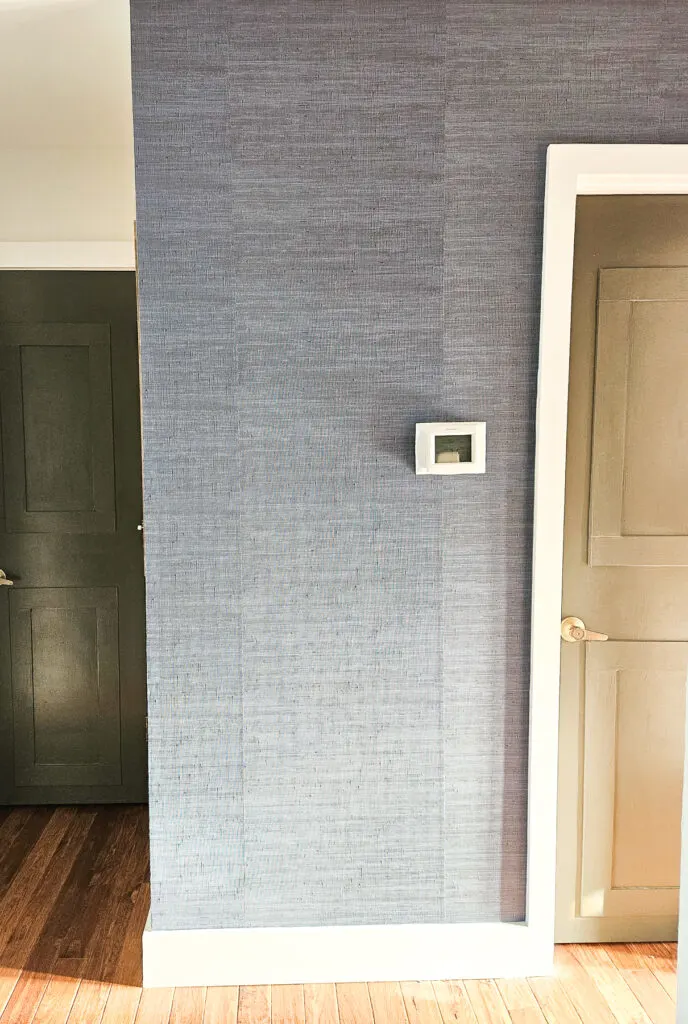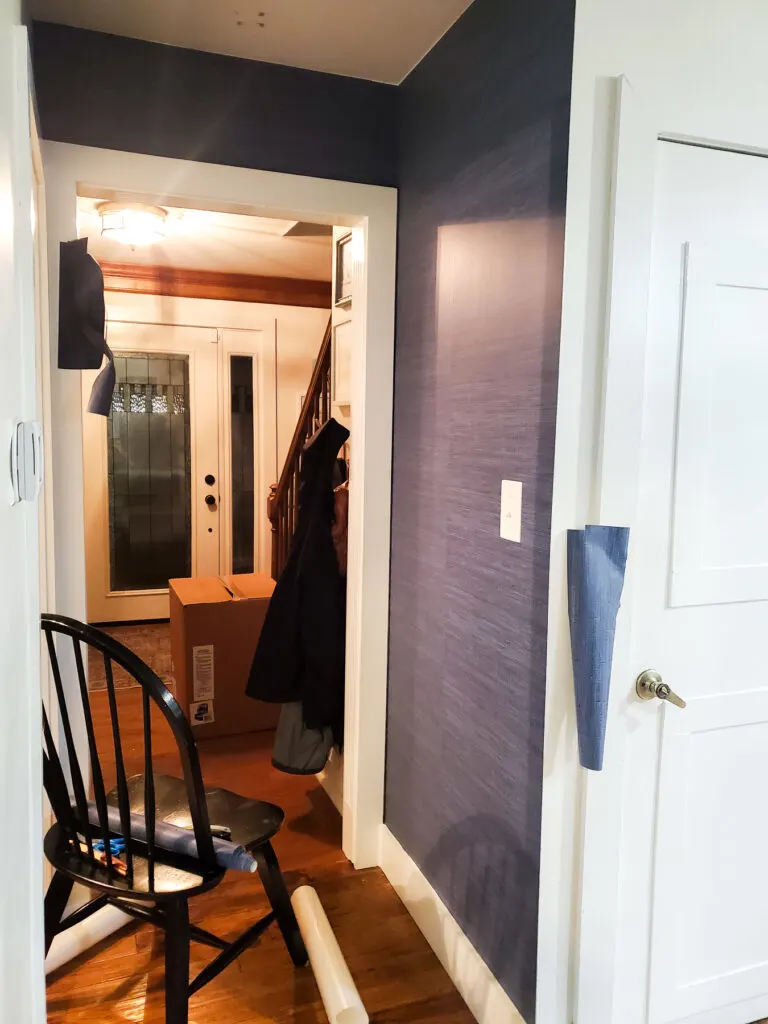Install peel and stick grasscloth, such as this blue grasscloth wallpaper, anywhere in your home. Try this simple project to create an accent wall with blue feature wallpaper.
Add an accent wall quickly and easily with peel and stick grasscloth. Whether it’s your living room, bedroom, or office, this beginner-friendly solution adds style. Go ahead, give your space a fresh look with a chic accent wall – it’s a simple project that will make a big statement!
After painting the walls white in our modern cottage kitchen on a budget, I quickly realized the white wouldn’t hold up well in the hallway-like entry to the kitchen. Handprints, dings, scuffs and more were common for this high-traffic location. After cleaning and repainting the wall several times, I started looking at alternative solutions.
Disclosure: This page includes affiliate links.
For high-traffic areas, vinyl wallpapers are a great option. Easy to clean and completely wipeable, peel and stick wallpapers are great options for areas of the home that take a lot of abuse. As an added bonus, wallpaper is a great method for creating a feature wall (like the grasscloth accent wall in our master bedroom). So, if you are struggling with a dirty, beaten-up wall in your home, consider turning it into a feature wall with a pretty peel and stick wallpaper.
Grasscloth Wallpaper vs Vinyl Grasscloth Wallpaper
Before we jump into the tutorial, let’s discuss the differences between traditional grasscloth wallpaper and vinyl grasscloth wallpaper. At a high level, traditional grasscloth is made of natural fibers and vinyl grasscloth is the faux version.
Real grasscloth wallpaper is made from strips of natural fibers such as raffia, jute, and seagrass. The strips are woven together creating a natural, organic, texture with varying dimension and color.
Contrary to vinyl grasscloth, “real” grasscloth is not easily wipeable. While it would hide dirt and scuffs better than a painted white wall, it will collect dust and cannot be cleaned with a wet rag. Instead, natural grasscloth wallpaper should be gently cleaned with the brush attachment on a vacuum.
Vinyl grasscloth is a faux replacement for traditional grasscloth wallpaper. It is less expensive than natural fibers since it is made of synthetic materials. Manufacturing grasscloth wallpaper from vinyl makes it both cheaper and wipeable. Therefore, for high-traffic areas (especially with kids and/or pets) or for high-moisture areas (such as bathrooms and laundry rooms), I recommend selecting a “faux” vinyl grasscloth instead of “real” natural grasscloth.
Even though the grasscloth is faux, that does not mean there will be no texture. Purchase a textured vinyl grasscloth to get the look and feel of traditional grasscloth. Our blue grasscloth wallpaper has a rough texture which mimics the feel of grasscloth fibers and stitching.
Grasscloth Wallpaper: Glue vs. Peel-and-Stick
While it might seem counter-intuitive, peel-and-stick wallpaper can be as difficult to install as wallpaper installation with glue. Why is that?
When installing wallpaper with glue, you are able to gently slide, shift, and tug the paper into place – aligning it with the adjacent strip of wallpaper to pattern match. In contrast, when installing peel-and-stick, it sticks where you place it and cannot be shifted. Therefore, if the peel-and-stick wallpaper is misaligned to the pattern, the only way to fix it is to pull the paper back off the wall and place it once again.
Misaligning and realigning the paper can get tedious which makes peel-and-stick frustrating. But, I’ve got good news:
Grasscloth wallpaper does not have a pattern match!
In general, most wallpapers have a repeating pattern which requires perfect alignment. The alignment of the pattern disguises the seams and keeps the pattern continuous across the wall:
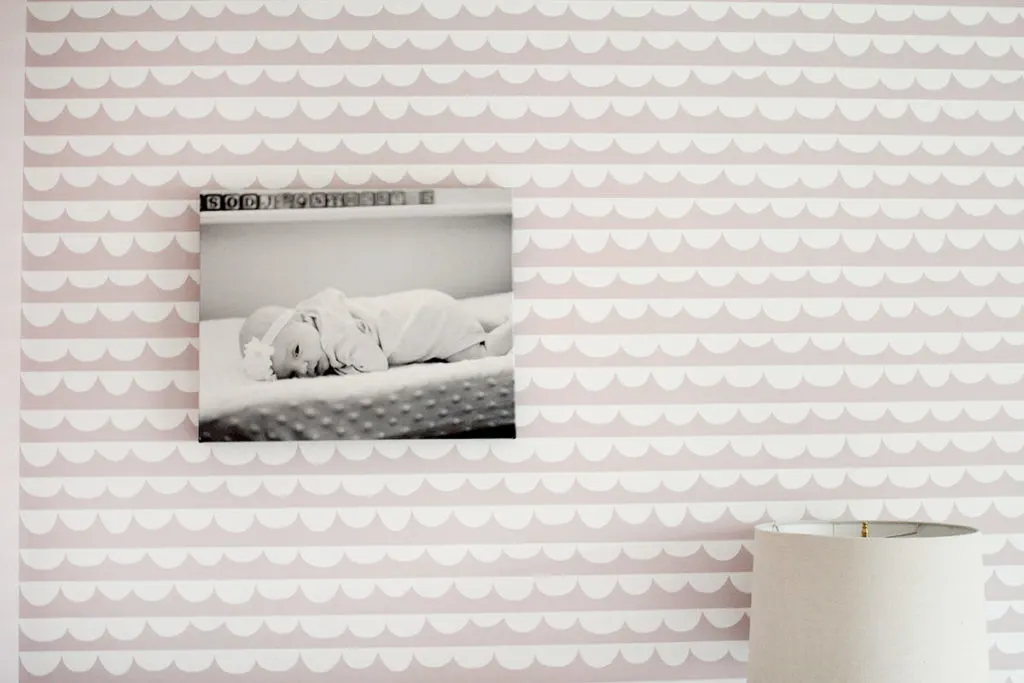
Since authentic grasscloth wallpaper is hand sewn from natural fibers, it cannot have a pattern match. In terms of hanging wallpaper, that is great news! With natural grasscloth wallpapers, you don’t have to worry about alignment or visible seams:
And, since vinyl grasscloth wallpaper is imitating the look of authentic grasscloth, you don’t have to worry about seams or pattern match with peel-and-stick grasscloth either:
So, if you are a beginner to wallpaper installation (either glue or peel-and-stick), grasscloth is a great first wallpaper project because it doesn’t require pattern match.
How to Install Peel-and-Stick Grasscloth Wallpaper
Before starting any wallpaper installation, make sure the walls are clean of dust and debris. Also, if there are any dents or dings in the wall, fill those in with spackling before you begin the install.
1. Begin in a Corner
Select a corner in which to begin the wallpaper. Generally, it is recommended to work from left to right. However, in this case, I started on the right because that corner was very visible and I wanted to ensure the line was clean and straight.
2. Pencil Mark a Straight Line on the Wall
Walls and ceiling lines are not typically straight. Therefore, do NOT simply align the wallpaper with the corner and assume that the corner is straight. Rather, mark in pencil a straight line on the wall using a level, chalk line level, or a laser level in combination with a measuring tape.
3. Start at the Ceiling Line
Beginning at the ceiling, and leaving approximately 2-3″ extra, start attaching the peel-and-stick wallpaper. Peel the backing off slowly to ensure you stay aligned with the pencil marks.
4. Smooth as you Go
Continuously press and smooth the peel-and-stick to avoid creating air bubbles. If you’ve ever installed contact paper, the method is similar. A flat-edged tool such as a squeegee – or simply use a credit card – will help to smooth out any air bubbles.
5. Install to the Baseboard
Continue installing the paper to the baseboard and leave an additional 1-2″ at the base.
6. Trim with a Utility Knife
Once the sheet is fully installed and straight, press the paper into the ceiling corner and along the baseboard edge, creating a crease. Use a utility knife to trim off the excess paper.
7. Repeat until Wall is Complete
Continue installing strips of peel-and-stick wallpaper, following steps 3-6. Use the edge of the previous strip as the guide (instead of pencil marks), but periodically check that the strip edge is still level.
8. Cut around Door Trim, Window Trim, and Other Obstacles
When you encounter obstacles, such as door and window trim, excess paper is your friend! Cut the paper too large and slowly work to create the creases around the trimwork. Then, use scissors and a utility knife to trim away the excess paper from around the obstacles.

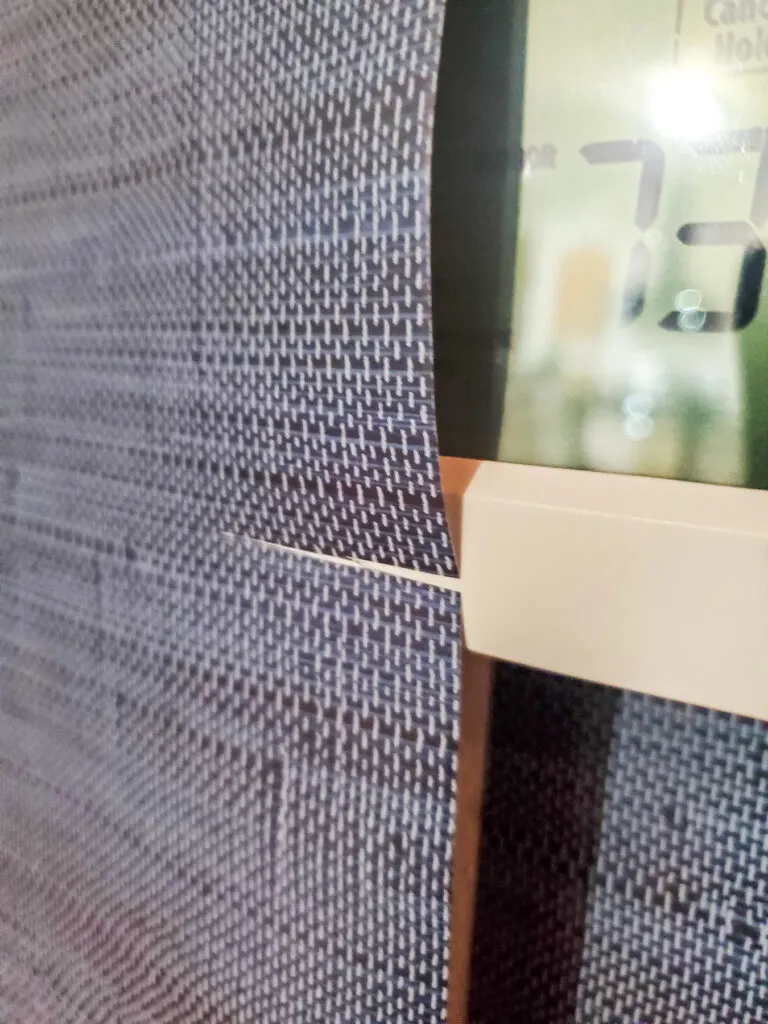
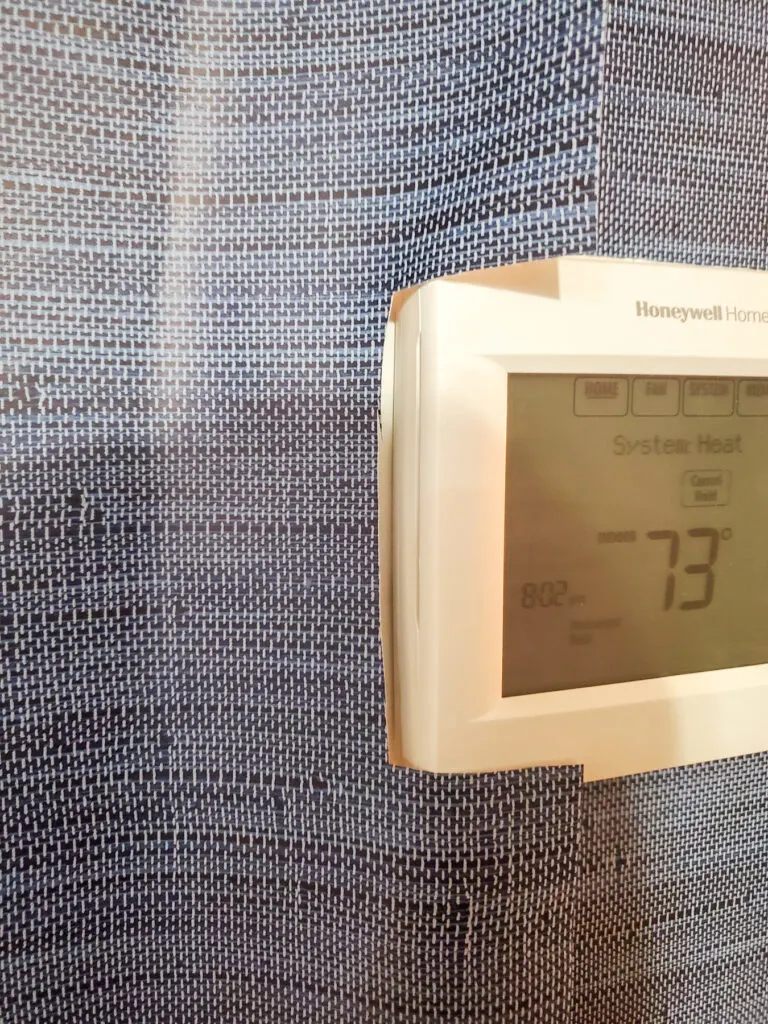

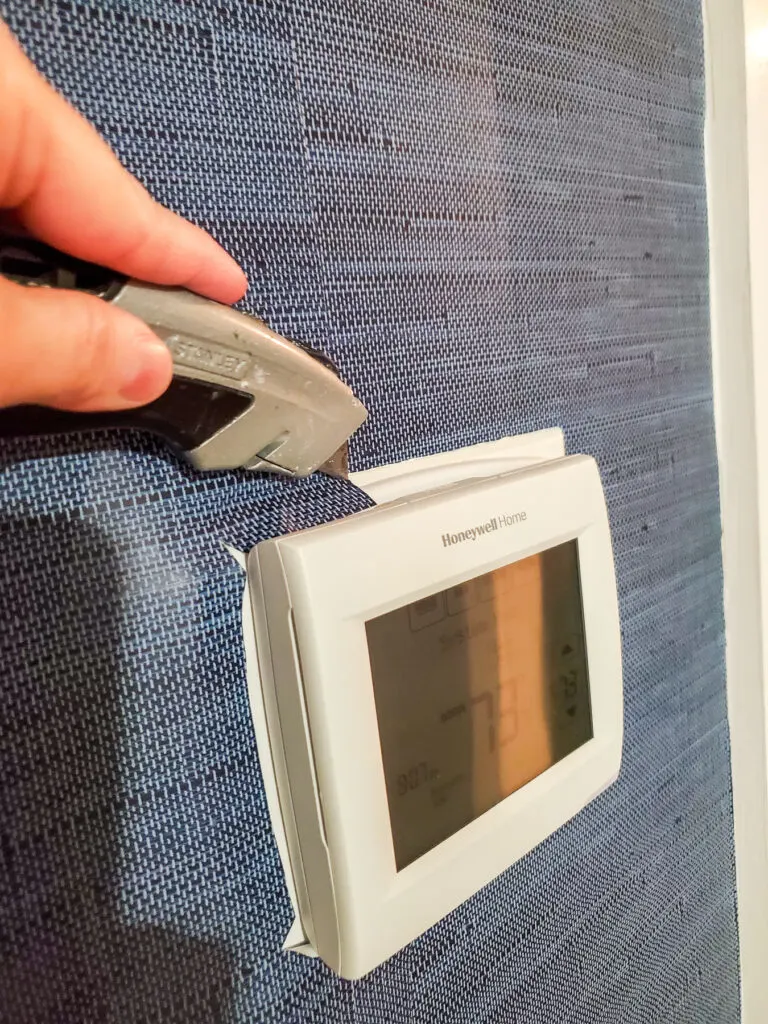
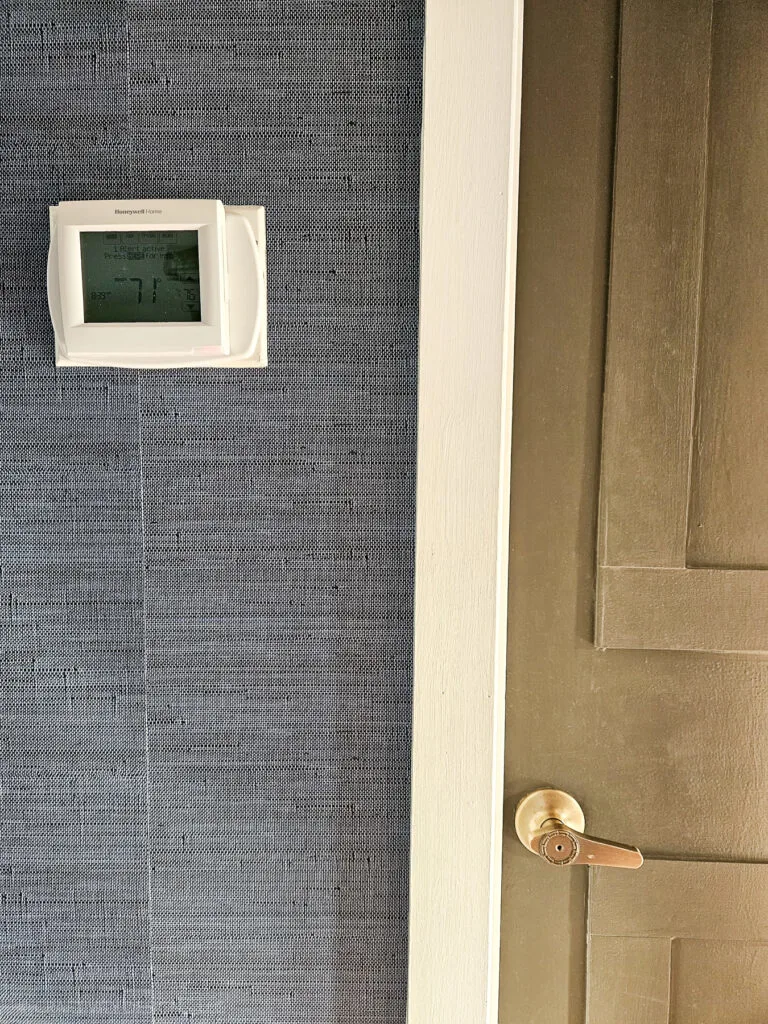
Hallway Accent Walls
Hallways are a great location for accent walls. Our kitchen, living room, dining room, and entry way all feature alabaster white walls with a combination of white or wood trim. This small hallway connecting those neutral spaces is the perfect spot for bold accent walls in blue grasscloth.
Did you like this DIY wallpaper project? You might also like:
- Jungle Wallpaper in a Powder Room
- Pink and White Wallpaper in a Girl’s Bedroom
- How to Create DIY Map Wallpaper on a Budget

